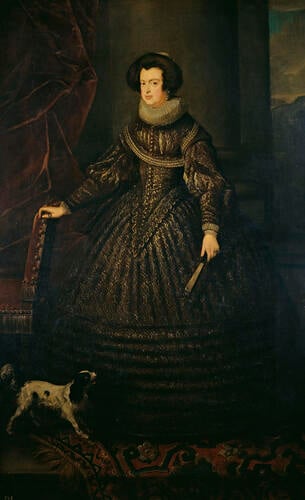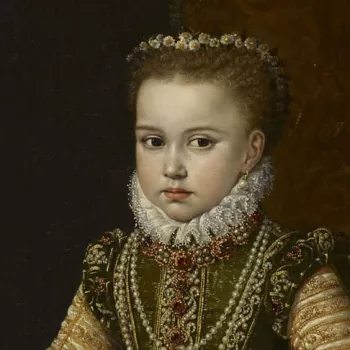Isabella of Bourbon (1602-1644), consort of Philip IV of Spain (1605-1665) c.1635-38
Oil on canvas | 238.5 x 147.8 cm (support, canvas/panel/stretcher external) | RCIN 402915
-
This lavish full-length portrait of Isabella of Bourbon, the first wife Philip IV of Spain is one of relatively few contemporary paintings of the Queen, who was notoriously reluctant to sit to artists. Almost all known portraits of Isabella of Bourbon are based on the equestrian portrait by court painter and master of the Spanish Golden Age, Diego de Velázquez (c. 1635-36, Museo del Prado, Madrid, P001179)
Isabella of Bourbon was born Elisabeth of France, the eldest daughter of King Henri IV and sister of Queen Henrietta Maria, wife of Charles I. In 1615 she married Philip IV, then Prince of Asturias and adopted the Spanish form of her name, Isabella. She reigned as Queen consort between 1621 and 1644. Known for her beauty and intelligence, Isabella was popular among her Spanish subjects and governed as regent during the Catalan Revolt. She died in 1644 aged forty-one.
The portrait shows the Queen richly dressed in a dark gown with a peaked bodice and embroidered with silver thread and decorated with slashes in the sleeves. She wears a double quilled ruff and three ropes of pearls pass over the right shoulder and loop around the bodice under the left arm. The Queen stands on a raised stone dais, partially covered by a Turkish carpet and rests her right hand on the back of a chair while holding a closed fan in her left. A small black and white King Charles spaniel, a traditional symbol of fidelity often found in portraits of Habsburg Queens, stands at her feet.
Portraits of Spanish Habsburg Queens were designed to be complementary to those of Kings and have a distinct iconography. Depicted in formal attitudes without humour or seductive charm, portraits of Habsburg Queens traditionally subordinate the individual to the body politic responsible for sustaining the legitimacy and succession of the dynasty.There are several versions of this composition, although this is the only known full-length. A three-quarter length portrait of the Queen in the Kunsthistorisches Museum, Vienna is believed to be by Velázquez; a second three-quater length version in the Art Institute of Chicago is attributed to the mater's workshop. There is also at least one bust-length version; however, this is almost certainly a later copy. The painting was one of three portraits sent to Charles I from the court in Madrid, mentioned in a letter from the English Ambassador to Spain, Sir Arthur Hopton, in 1638. Two of the portraits, depicting Philip IV and Infante Balthasar Carlos (RCINs 402914 and 403019), appear to have been painted by the same hand, almost certainly Juan Bautista Martínez del Mazo (1610/15-1667). However, that of Isabella of Bourbon was seemingly painted by a different artist. The thorough attention paid to the details of the Queen's dress are a contrast to the quick and decisive technique associated with Velázquez, making it more likely that the portrait was painted by another artist working in his studio; however, the portrait head is of sufficient quality that it may have been painted by the master himself.
All three portraits have been extended with extra strips of canvas. While the texture of the additional canvas is different to that of the central section, in this portrait, the dog and the carpet appear to be continuously painted over the join, with no detectable change in paint or technique. This suggests that the additions were completed at a very early date in the history of the painting, probably before it left the artist's studio. Though the additions appear in different places across the three paintings, the central section of canvas is roughly the same for both the portrait of Philip IV and that of Isabella of Bourbon.
Provenance
Probably one of the portraits given to Charles I in 1638 by Sir Arthur Hopton, English Ambassador in Madrid; listed in the Commonwealth Sales in the Cross Gallery at Somerset House (no 325), sold with its pair for £40 on 23 October 1651; recovered after the Restoration and back in the Cross Gallery at Somerset House in 1710 (no 28)
-
Creator(s)
(nationality)Acquirer(s)
-
Medium and techniques
Oil on canvas
Measurements
238.5 x 147.8 cm (support, canvas/panel/stretcher external)
264.2 x 173.4 x 7.0 cm (frame, external)
Category
Object type(s)
Alternative title(s)
Elisabeth of France (1602-1644), consort of Philip IV of Spain (1605-1655)
Queen Isabella of Spain (1602-1644), consort of King Philip IV (1605-1665)









